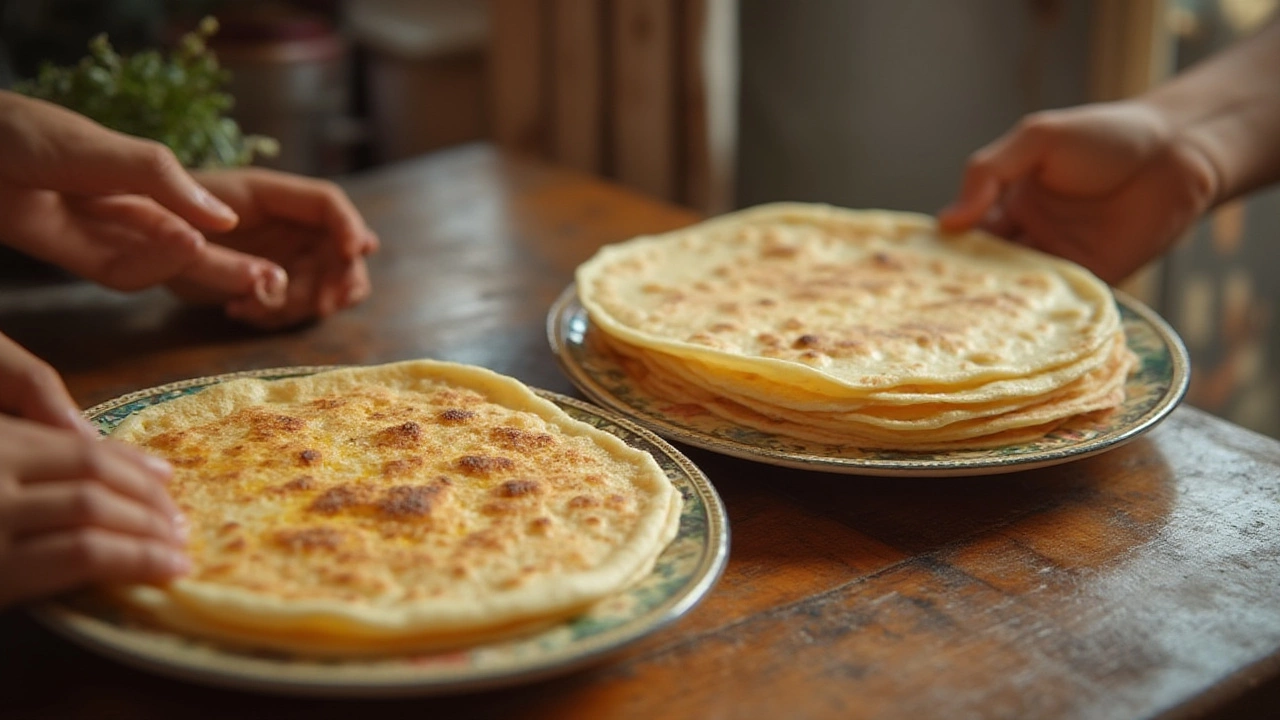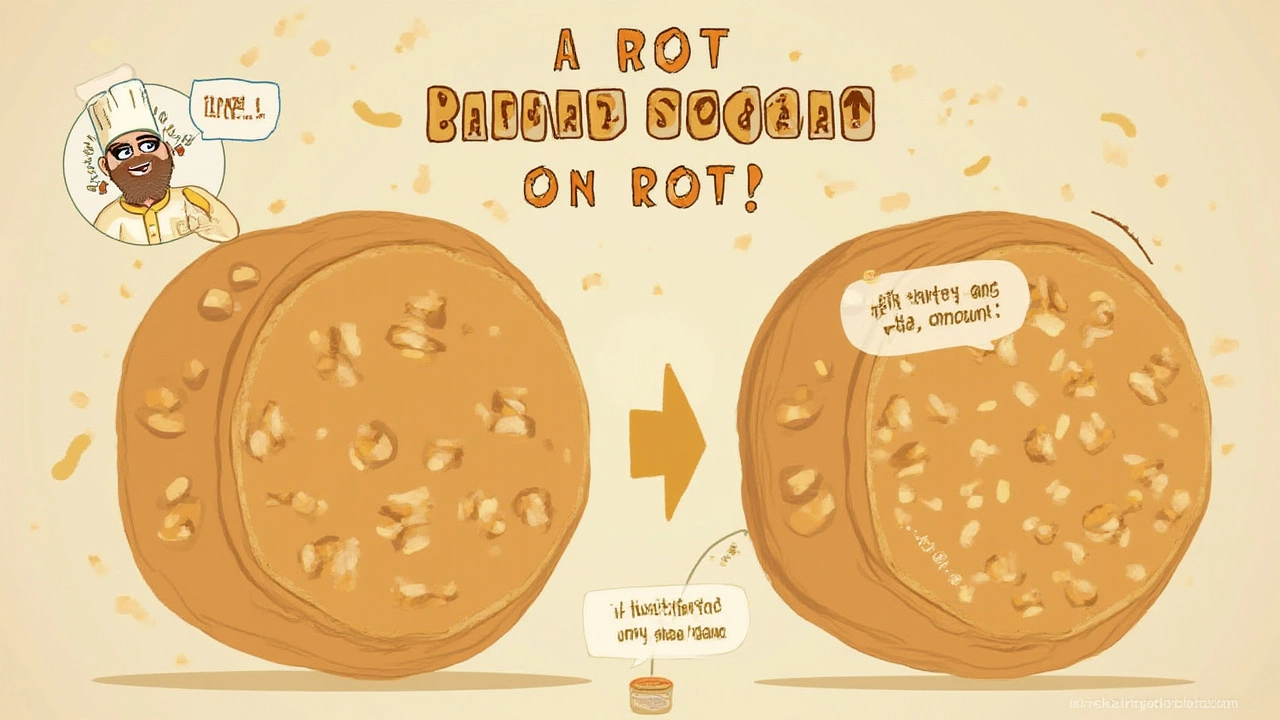Baking Soda in Roti: Should You Use It or Not?
 Jul, 25 2025
Jul, 25 2025
You might think of roti as one of the simplest Indian foods—just flour and water, right? But walk into kitchens across India, and you’ll quickly realize that debates about making the softest, puffiest roti can get heated. One question pops up more than you’d expect: Do you add baking soda to roti dough? Some home cooks swear by it, promising pillow-soft results every time. Others insist it’s not only unnecessary but might actually ruin this age-old classic. With all the tips, myths, and mistakes floating around, it’s easy to get confused. So let’s roll up our sleeves and get to the bottom of the baking soda mystery.
The Traditional Way: What Goes Into Classic Roti
For generations, roti—the heart of an Indian meal—has stayed basically the same; just whole wheat flour (atta), water, and sometimes a drizzle of ghee. Knead, rest, roll, and roast. That’s the rhythm. Roti isn’t meant to be complicated. But why do some rotis turn out soft and pliable, while others end up chewy or dry? It often comes down to technique and flour quality. Indian whole wheat flour (not all-purpose!) has extra bran, giving roti that earthy taste and chew.
Most traditional cooks wouldn’t dream of adding baking soda. Instead, the focus is on kneading long enough—at least 8-10 minutes. You want a smooth, springy dough. Letting the dough rest for 20-30 minutes, covered with a damp cloth, gives gluten time to relax, making it easier to roll out thin discs. Some people add a spoon of oil or ghee for softness, but not much else goes in. When cooked on a hot tawa (griddle), moisture in the dough turns to steam, puffing up the roti naturally. That’s why rest time, flour type, and high heat matter so much in making the perfect roti.
Adding extras like baking soda hasn’t been a common practice in rural or traditional homes. For lots of families, changing the classic recipe is something of a cultural no-no. Many grandmothers will say: the only trick to soft rotis is practice. Mastering the feel of the dough, the right rolling pressure, and timing is the key. If you ask around, you’ll find that most top chefs and veteran home cooks never use baking soda in their basic recipe.
But food traditions evolve, right? Let’s see why some modern cooks reach for baking soda anyway.
Why Add Baking Soda? The Science of Softer Rotis
Here’s where things get interesting. Baking soda, or sodium bicarbonate, is a leavening agent. It reacts with acid and moisture in dough, producing carbon dioxide bubbles. That’s how it makes cakes and cookies rise. But how does it work with rotis? Rotis usually don’t have any acid (like yogurt or lemon juice), so the baking soda doesn’t create a dramatic rise. Still, adding a pinch—the key word being pinch—can change the dough’s pH. This makes gluten strands relax more, giving you a slightly softer and more tender roti.
Some cooks found out, maybe by accident, that an almost invisible amount of baking soda helps when your flour is old or coarse. It can add some fluffiness, especially if you want to skip the oil or if your rotis always come out hard. People who make rotis in big batches—canteens, dhabas, or large-scale kitchens—sometimes add baking soda to cut down on rest time or to guarantee softer bread for hours after cooking. Also, in certain parts of India, recipes like phulka or bhakri might involve a tweak or two, depending on local traditions or the flour used.
But there’s a catch. Too much baking soda can wreck the taste, turning the roti bitter or oddly alkaline. You don’t really want that faint soapy aftertaste with your dal. Plus, the dough can get too loose and sticky, making it impossible to roll out properly. Here’s a neat trick, though: some cooks use a mix of baking soda and yogurt. The acid from the yogurt activates the soda, and the resulting roti is often softer and tastier—closer to naan or kulcha. That said, purists still prefer just flour, water, salt, and maybe a glaze of ghee.
The bottom line: Using baking soda isn’t traditional, but it can help in certain situations—tough flour, time crunch, or old grains. But always—and I mean always—use less than 1/8 teaspoon per 2 cups of flour. More isn’t better here.

Baking Soda, Baking Powder, or Yeast: Which One and When?
Lots of people get mixed up between baking soda, baking powder, and yeast. Each one works differently, so slipping one in for another won’t magically fix hard roti. Baking soda is pure sodium bicarbonate, while baking powder contains sodium bicarbonate plus an acid and a starch. Yeast is a whole living organism—a totally different beast—that ferments dough and gives breads like pav and baguette their distinct rise.
If you want puffier, thicker Indian breads—think naan, bhature, or kulcha—you’ll often use some baking powder or yeast. These breads are supposed to have an airy, spongy texture. For them, bakers add yogurt, ferment the dough, and sometimes include both baking soda and baking powder. You’ll never find yeast in a proper roti, though. Roti is all about thinness, softness, and a quick cook.
Some urban kitchens add a tiny bit of baking powder to regular roti dough, but the difference is minor. Both baking soda and baking powder can help soften the dough—but if you’re after classic roti texture, less is definitely more. Overdoing it means you risk a weird flavor or rubbery feel. A cool tip: If you ever run out of fresh flour at home and only have old, stale flour, adding a pinch of baking soda and a spoon of yogurt can revive the dough enough to make it edible and soft.
Still, if you experiment, keep notes! Every household kitchen is a mini science lab. The exact amount of water, flour protein, local humidity, and kneading style can change your roti completely. Practice is the only way to really master these subtle differences. But if you’re aiming for health benefits and a nutty, earthy taste, stick with whole wheat, no-leavening roti as the nutritionists recommend.
Nutrition Talk: Does Baking Soda Change the Health Value?
If you’re eating homemade roti for health reasons, you probably don’t want to mess around with additives. Whole wheat roti is a fiber and protein powerhouse—each roti (35g) giving you about 3g of protein and 2.8g of fiber. It scores way better than all-white flour breads, especially for managing blood sugar and aiding digestion. But what happens when you add baking soda?
The good news: baking soda isn’t harmful in small amounts. But excessive use can lead to higher sodium in your diet. One-eighth teaspoon of baking soda has about 150mg of sodium. That might not sound like much, but if you eat several rotis a day, it adds up fast. Diet experts often warn that extra sodium leads to bloating, high blood pressure, and other health risks, especially as you age. For people on a low-sodium diet, it’s best to keep baking soda use to a bare minimum—or skip it entirely.
Another thing to consider is flavor. Traditional, simple rotis have a nutty sweetness from the whole wheat. Baking soda can dull those natural flavors. It makes the dough more alkaline and can also impact how vitamins and minerals are absorbed. For example, it may slightly reduce some of the B vitamins due to the pH change. The effect is small but worth thinking about if you eat roti every single day.
Below is a simple table comparing nutrition for rotis with and without baking soda:
| Classic Roti (no soda) | Roti with Soda | |
|---|---|---|
| Calories (per 35g) | 110 | 110 |
| Protein (g) | 3.0 | 3.0 |
| Fiber (g) | 2.8 | 2.8 |
| Sodium (mg) | 2-5 | 152 (with 1/8 tsp soda) |
| Fat (g) | 0.6 | 0.6 |
| B Vitamins | Good | Slightly reduced |
baking soda in roti isn’t a nutritional disaster, but it’s not a health boost either.
The best way to keep your roti both soft and healthy? Use fresh flour, knead well, and don’t skip the rest time. Add a bit of oil or ghee for flavor, rather than trying to cheat softness with chemicals.

Tips, Tricks, and Mistakes Everyone Makes
If you ever wondered why restaurant rotis always seem softer, here’s a secret: it’s not just about magic ingredients. Their dough rests longer and is often kneaded in large batches, which makes a difference. Some also brush finished rotis with ghee or butter to lock in moisture. But what about everyday home cooking?
- Use warm water to knead the dough: This hydrates the flour better, making the dough smoother and softer.
- Don’t rush resting time: Give dough at least 20 minutes under a damp cloth. If you let it sit even longer, say 30-40 minutes, you’ll see a real jump in softness.
- Knead thoroughly but not roughly: Gentle, steady kneading develops gluten without making the dough tough.
- If using baking soda, stay under 1/8 teaspoon per 2 cups of flour: And always mix it well into the dry flour before adding water, for even distribution. More than that can ruin texture.
- Add oil or ghee (optional): Just 1-2 teaspoons per 2 cups of flour adds richness and softness without affecting nutrition much.
- Roll evenly and thinly: Too thick, and the roti might not cook through; too thin, and it’ll dry out.
- Cook on a hot tawa: Preheat your griddle for at least 3 minutes on medium-high before placing rotis; a cold tawa makes hard or doughy bread.
- Store rotis wrapped in a clean cloth: This keeps them steamy and soft until eating.
If your rotis come out tough, you might be using old flour, kneading too little, or skipping the resting stage. Adding more water, using fresh flour, and kneading longer will help more than baking soda, especially if you want classic roti flavor and texture.
One common mistake is rolling the dough with too much dry flour. This soaks up extra moisture and makes rotis dry. Dust off excess flour before rolling out each roti disc, and use just enough to keep the dough from sticking.
And here’s a cool fact: In states like Gujarat and Rajasthan, where rotis are a daily ritual even in dry, hot weather, cooks sometimes cover cooked rotis immediately with a second plate. This keeps them steamy and extra pliable—even without baking soda or fancy tricks.
If you ever try baking soda, do a side-by-side taste test. Make half a batch plain, half with soda, and see which you prefer. More often than not, people come back to the basics. But if you want quick, reliable softness (like if you’re packing lunchboxes hours in advance), just a pinch of baking soda, well mixed, won’t hurt. Just remember: It’s an option, not a must.